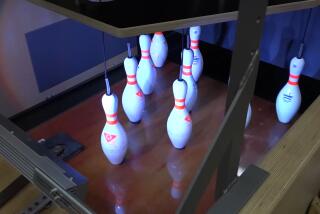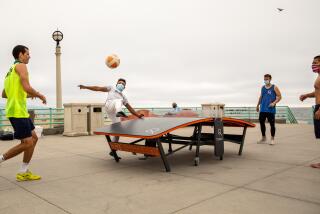SPORTS: THE NEXT DECADE : Flippers and Fins in a New Lunar Society
- Share via
The great sports that attract the hearts and minds of millions have been the result of evolutionary changes over the centuries and might be traced back to medieval or even ancient times. The one exception is basketball which, in 1891, was created full blown by James Naismith. Baseball is not another exception. Although supposedly invented by Abner Doubleday in 1839, that is well understood to be a pious fiction designed to show the game to be of American origin which it undoubtedly is not. Even minor sports such as polo have long and intricate histories.
In looking into the 21st Century, then, it would be useless to attempt to imagine totally new games invented all at once. That has happened only one time, a century ago, and since then, nothing like it has happened again. Nor would such a thing be predictable. If, in 1890 people were told that in the space of a year a sport would be invented that would eventually take the world by storm, who could possibly have predicted basketball?
What we must do, then, is to look into a future of continued evolution and modification of sports that already exist; find something that is reasonably likely to come to pass and that will so alter the ground rules of a game as to make the sport move in a novel but inevitable direction.
This will happen, for instance, if we establish a full-blown human society on the Moon, something that may well take place in the 21st Century, if humanity remains sane enough not to destroy itself, and if it does not fall prey to a failure of nerve.
We needn’t, for our purposes in this essay, try to describe how we can make such a lunar society possible--where the energy is to come from, how we work up an underground city with an appropriate air and water supply, and so on. It can be done, but it will waste time trying to describe it.
Let us merely say that human beings will endeavor to build a sub-surface world on the Moon as similar to that on Earth as possible. And one thing that will surely exist in the Lunar city will be sports arenas, where baseball, football, soccer, tennis, basketball and golf can be played.
So far, so good. We can imagine the games proceeding as on Earth--but if we do our imagination falls short, for in one respect the Moon will differ from the Earth, no matter what we do. The surface gravity on the Moon is only one-sixth that on the Earth.
That means that a ball struck by a club or a bat or a hand, will go as quickly as it does on Earth but it will be bent out of it in a straight line path to only one-sixth the degree it would be on Earth. If we don’t want the ball to go too far it will have to be more massive than the ball used for analogous games on Earth.
The human response would also have to be radically different.
A person could jump higher on the moon than on the Earth, but he would tend to gain height slowly and to come down slowly. He might find it necessary to maneuver in air a bit more dexterously than he ever would on Earth.
I imagine that an athlete on the Moon is likely to need a dorsal fin running partway down his backbone, so as to lend him stability and to reduce the tendency to turn in either direction. He might also have flippers on his feet and knees and elbows to make it possible to direct his motions more deliberately.
This would be particularly useful, perhaps, in a game like lunar tennis, which would take on an almost three-dimensional motif.
And, of course, it would require unique skills. Merely donning the fins won’t necessarily mean a thing. People will have to be able to manipulate them properly and do the equivalent of swimming in air, which will require specialized talents that may exist only rarely and unpredictably. A crackerjack two-dimensional tennis player may find himself totally helpless if expected to maneuver three-dimensionally, and vice-versa. The two games will thus be totally different as art-forms, and this may hold for all the other sports. A baseball outfielder on the Moon would shoot into the air and linger there trying to intersect the ball.
For that matter, think of what can be done with ballet on the Moon, or with gymnastics, or with ordinary ballroom dancing. Almost all coordinated physical activities would take on a new grace--and a new danger.
Where does the dancer come in? Easy. Every object has a mass. It is the size of the mass that dictates how hard it is to get a thing moving and how hard it is to stop it moving once it starts. Every object also has a weight. It is the size of the weight that decides how strongly it if attracted to Earth, how easy it is to lift and so on. On Earth, mass and weight are very closely associated and we judge one by the other so that we have no trouble.
On the Moon, however, although weight is just one-sixth what it is on Earth, mass remains exactly the same. An object may seem very light but it is much harder to set it moving than would be true if you were working with something that felt that light on Earth. It would also be much harder to stop it once moving than you would expect. In short, you will have to be careful not to judge mass by weight or you might play a ball improperly or, worse yet, be hurt.
We can go a step further in our imagination. Suppose we have large, enclosed arenas in orbit about the Moon, or about the Earth, for that matter.
Within those arenas, the gravitational pull would be just about zero. (But mass would still be exactly as it was on Earth, so you would have to be more careful than ever.)
Balls would move in virtually straight lines. Fins and flippers would be even more elaborate and people would, in a true sense, fly.
We have all seen astronauts tumble more or less slowly within the cramped confines of their spaceships. Inside a large arena, equipped with fins and flippers, they will move more rapidly and gracefully.
You would have not only low-gravity sports with partial three-dimensional effects. One wonders, if in addition to the fins and flippers there might not also be small reaction devices, fizzing off carbon dioxide or argon which would give the players a rocket assist and speed up the game further.
Naturally, it would be difficult to assume the existence of seats in the arenas. We would need as much room as possible for the players and the games, but there will be television cameras included and (we can hope) that people on Earth and Moon will, in the 21st century, watch precision sports such as no one has ever seen through the 20th Century, and few have even imagined.
More to Read
Go beyond the scoreboard
Get the latest on L.A.'s teams in the daily Sports Report newsletter.
You may occasionally receive promotional content from the Los Angeles Times.










